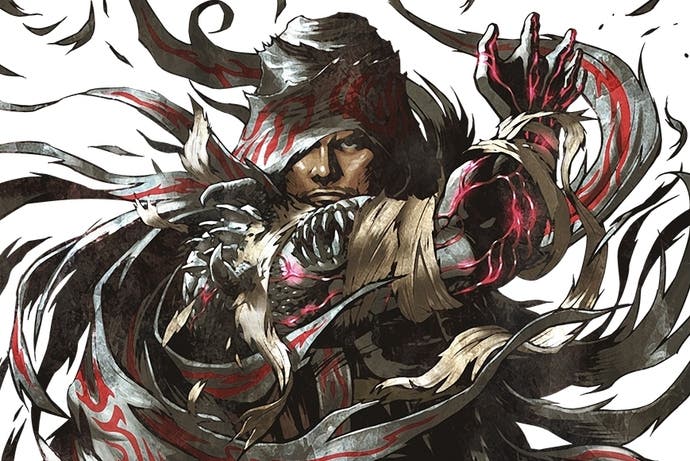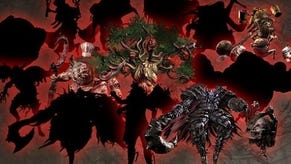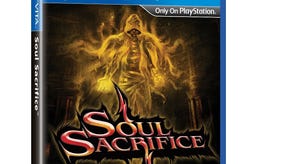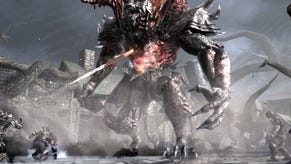Soul Sacrifice review
Soul survivor.
It's been over a year since the PlayStation Vita launched, and despite some excellent games like Gravity Rush and Persona 4 Golden, it's fair to say that we're still waiting for its killer app. We'd love to say that Keiji Inafune, Sony's Japan Studio and Marvelous AQL have finally cracked that code - but although Soul Sacrifice has a lot going for it, it falls into the trap of style over substance.
The story focuses on a nameless slave who is captured and then imprisoned by a powerful sorcerer. At first, it seems like the slave's situation is pretty hopeless. All he can do is crawl around his cell with nothing but oversized bugs to keep him company. But when a talking book named Librom appears from a pile of rubble, the slave is offered a potential lifeline. By reading Librom's pages he can relive the author's memories. This allows him to slowly learn the art of casting magic spells and unravel the mystery behind the sorcerer who has imprisoned him.
The way the story is told through the pages of Librom is one of the game's strongest suits. Soul Sacrifice has clearly been built on a modest budget and yet the simple silhouettes and sombre soliloquies help bring this grim fairytale to life. It's not the kind of story that will stay with you long after the credits have rolled, but much like the short stories in Lost Odyssey, it's handled with minimalist elegance. It's just a shame the gameplay doesn't live up to the dark fantasy painted by these words.
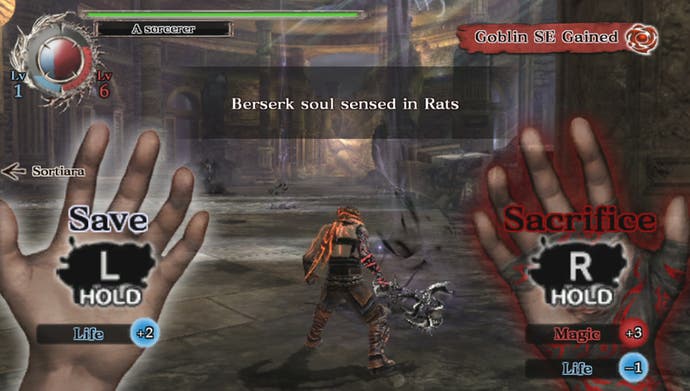
It might be too simplistic to claim that Soul Sacrifice is monster hunting for wizards, but it's not that far off the mark. Librom's pages make up a journal of individual quests that steadily unlock as you play through them. Finishing the main quest will take upwards of 10 hours if you keep the blinders on and remain focused. There are also 15 or so self-contained side-stories that improve the mileage considerably, and with the focus being on progressive character development - at least in a numerical sense - you can also replay any mission to grind for spells and increase your level.
Every mission tasks you with slaying a pack of smaller enemies or one of the larger Archfiends. To achieve this, you can select up to six spells to take into battle. Your repertoire starts off fairly basic, with flaming swords for close encounters, rocky shields for blocking heavy assaults and frozen projectiles that can pinpoint an enemy's weak spot. Then, as you gain more potent sorcery by completing missions and fusing your old spells together, you'll have the opportunity to summon durable golems, conjure circles of healing and even morph into a burning ball of destruction.
The twist - one that Soul Sacrifice makes a big song and dance over - is whether you choose to save or sacrifice your fallen foes. Sacrificing the lesser enemies is necessary during the protracted battles, as it replenishes the number of times you can cast each spell. Saving, meanwhile, is the only way to recruit an Archfiend's human form so they can aid you as an AI partner during the side-stories. Saving also heals you slightly, but it's much more effective to simply sacrifice one of the weaker enemies before firing off a healing spell.

The enemy designs lie somewhere between Japanese folklore and Greek mythology, and while the cannon fodder is limited to demonic cats, rats, crows and spiders, the Archfiends get pride of place with around 20 nightmarish designs. There's the Hydra that chases you down with its multiple snake heads, the Cyclops that burrows underground before impaling you with its trident and the glutinous Slime that spews an endless torrent of grizzly confetti. Each one has been animated to a pleasingly high standard and they can absorb a considerable amount of punishment before returning to their human forms.
The problem is that many of them look far better than they function. I lost count of the times I was able to continually bombard an enemy from a safe distance with a mortar-like spell - only stopping to sacrifice a few lesser enemies to reload my stocks. And even when I had to adapt my tactics for the faster-moving Cerberus and Phoenix, the AI would often fall for another cheap trick. One of the most effective was running around the same piece of scenery while firing off a few pot-shots once I'd built up enough distance.
This is partly the fault of the condensed arenas where each battle is staged. They range from a ruined desert city to a lake surrounded by floating chains, and they all look distinct on the surface, but they're completely lacking in personality when it comes to structure. The only time you need to directly interact with a stage is when you're low on magic and need to draw upon the spells that lay dormant within the scenery. Aside from that, they're entirely static and offer little more than colourful cover.

As harsh as all this sounds, I still enjoyed the manic battles against the more capable Archfiends - especially when playing co-operatively with up to four other players. At time of writing, the European servers were effectively barren, so we had to make use of the ad-hoc functionality instead of the online modes. One of the more interesting features is the ability to sacrifice a fallen ally for a screen-filling spell that causes massive damage. It's a bit of an ungentlemanly move, but the sacrificed player can still play a part by buffing the other players from the grave... that is, if they want to.
I really wanted to love Soul Sacrifice rather than just like it, but as much as it tries to differentiate itself thematically from its main competitor, the comparisons with Monster Hunter are more or less unavoidable. While Capcom's colossal safari is a master-class in intelligent enemy design and rewarding, consistently challenging combat, Soul Sacrifice throws caution to the wind by giving the player a vast array of options. The result is that it feels mechanically chaotic rather than refined.
Even so, the evocative setting and tangible narrative help propel you on a journey where taming every Archfiend and building an unstoppable collection of spells quickly becomes the driving force. It's just a shame that behind all the mythical monsters and magical flourishes there isn't an equally accomplished gameplay system that actively encourages you to learn and exploit the nuances of your prey. A worthwhile stopgap, then, but the wait for the Vita's defining magic moment continues.
